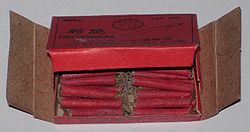- Squib (explosive)
-
A squib is a miniature explosive device used in a wide range of industries, from special effects to military applications. It resembles a tiny stick of dynamite, both in appearance and construction, although with considerably less explosive power. Squibs consists of two electrical leads which are separated by a plug of insulating material, a small bridge wire or electrical resistance heater, and a bead of heat-sensitive chemical composition in which the bridge wire is embedded.[1] Squibs can be used for generating mechanical force, or to provide pyrotechnic effects for both film and live theatrics. Squibs can be used for shattering or propelling a variety of materials.[2]
A squib generally consists of a small tube filled with an explosive substance, with a detonator running through the length of its core, similar to a stick of dynamite. Also similar to dynamite, the detonator can be a slow-burning fuse, or as is more common today, a wire connected to a remote electronic trigger.[3] Squibs range in size, anywhere from 2 to 15 millimeters in diameter.[2]
In the North American film industry, the term squib is often used to refer variously to: electric matches and detonators (used as initiators to trigger larger pyrotechnics). Squibs are generally (but not always) the main explosive element in an effect, and as such are regularly used as “bullet hits”.[2]
Contents
Uses
Squibs were once used in coal mining to break coal away from rock. In the 1870s, some versions of the device were patented and mass-produced as "Miners' Safety Squibs".[4]
Today, squibs are widely used in the motion picture special effects industry to simulate bullet impacts on inanimate objects. Items such as sand, soil, or wood splinters may be attached to the squib to simulate the "splash" that occurs when bullets pierce different materials.[2]
Although squibs were once used even for the simulation of bullet hits on live actors, such use has been largely phased out in favor of more advanced devices that are safer for the actor, such as miniature compressed gas packs. These alternate devices are often still referred to as "squibs" even though they do not use explosive substances. The devices (whether explosive or not) are coupled with small balloons filled with fake blood and often other materials to simulate shattered bone and tissue.[5]
Squibs are used in emergency mechanisms where gas pressure needs to be generated quickly in confined spaces, while not harming any surrounding persons or mechanical parts. In this form, squibs may be called gas generators. One such mechanism is the inflation of automobile air bags. In military aircraft, squibs are used to deploy countermeasures, and are also implemented during ejection to propel the canopy and ejection seat away from a crippled aircraft. They are also used to deploy parachutes.[3] Squibs are also used in automatic fire extinguishers, to pierce seals that retain liquids such as halon, fluorocarbon, or liquid nitrogen.
History
Scott v. Shepherd 96 Eng. Rep. 525 (K.B. 1773) Squibs are mentioned in a prominent tort case from eighteenth-century England. A lit squib was thrown into a crowded market by the defendant, and tossed from bystander to bystander until it exploded in the plaintiff's hands.
Squibs were originally made from parchment tubes, or the shaft of a feather, and filled with fine black powder. They were then sealed at the ends with wax. They were sometimes used to ignite the main propellant charge in cannons.[6]
Squibs were first used to simulate bullet impacts in the 1955 Polish film Pokolenie by Andrzej Wajda, where for the first time audiences were presented with a realistic representation of a bullet impacting on an on-camera human being, complete with blood spatter. The creator of the effect, Kazimierz Kutz, used a condom with fake blood and dynamite. [7]
Origin of the phrase "damp squib"
While most modern squibs used by professionals are insulated from moisture, older uninsulated squibs needed to be kept dry in order to ignite, thus a "damp squib" was literally one that failed to perform because it got wet. Often misheard as "damp squid",[8] the phrase "damp squib" has since come into general use to mean anything that fails to meet expectations.[9] The word "squib" has come to take on a similar meaning even when used alone, as a synonym for dud.[10]
See also
References
- ^ Thibodaux, J.G.. "Special Rockets and Pyrotechnics Problems". Langley Research Center. NTRS. http://ntrs.nasa.gov/search.jsp?R=19620007196. Retrieved July 1, 1961.
- ^ a b c d "Top 10 Frequently Asked Questions". Fantasy Creations FX. http://www.fantasycreationsfx.com/index.php?option=com_content&task=blogcategory&id=7&Itemid=26.
- ^ a b US 5411225 “Reusable non-pyrotechnic countermeasure dispenser cartridge for aircraft.”
- ^ Wallace, Anthony F. C. (1988). St. Clair, a nineteenth-century coal town's experience with a disaster-prone industry. Cornell University Press. p. 50. ISBN 978-0801499005. http://books.google.com/books?id=4fqyj_xAmOsC.
- ^ Grossman, Andrew. "Bleeding Realism Dry". Bright Lights Film Journal. p. 2. http://www.brightlightsfilm.com/37/bleeding1.htm.
- ^ Calvert, James B.. "Cannons and Gunpowder". University of Denver. http://www.du.edu/~jcalvert/tech/cannon.htm.
- ^ J.Sz., Gazeta Wyborcza, 2008
- ^ "Damp Squid: The top 10 misquoted phrases in Britain". The Daily Telegraph (London). 24 February 2009. http://www.telegraph.co.uk/news/uknews/4799157/Damp-Squid-The-top-10-misquoted-phrases-in-Britain.html.
- ^ "Definition of damp squib". Allwords.com. http://www.allwords.com/word-damp%20squib.html.
- ^ "squib: Definitions, Synonyms". Answers.com. http://www.answers.com/topic/squib.
Categories:- Explosives
- Pyrotechnics
Wikimedia Foundation. 2010.

